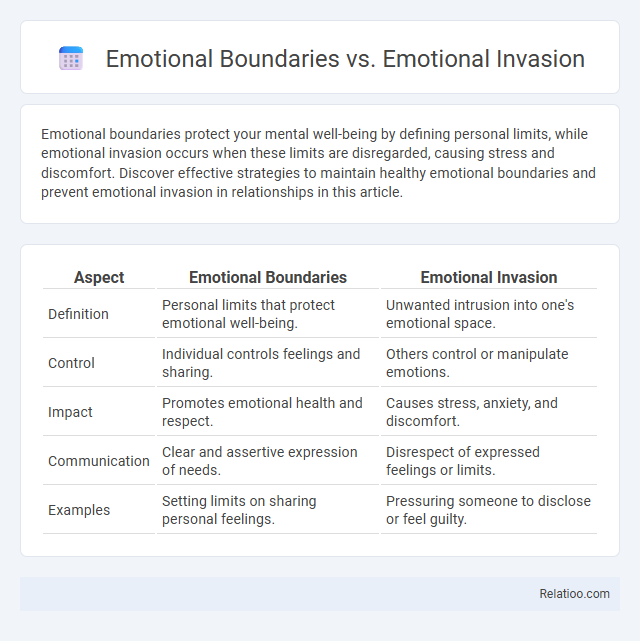Emotional boundaries protect your mental well-being by defining personal limits, while emotional invasion occurs when these limits are disregarded, causing stress and discomfort. Discover effective strategies to maintain healthy emotional boundaries and prevent emotional invasion in relationships in this article.
Table of Comparison
| Aspect | Emotional Boundaries | Emotional Invasion |
|---|---|---|
| Definition | Personal limits that protect emotional well-being. | Unwanted intrusion into one's emotional space. |
| Control | Individual controls feelings and sharing. | Others control or manipulate emotions. |
| Impact | Promotes emotional health and respect. | Causes stress, anxiety, and discomfort. |
| Communication | Clear and assertive expression of needs. | Disrespect of expressed feelings or limits. |
| Examples | Setting limits on sharing personal feelings. | Pressuring someone to disclose or feel guilty. |
Understanding Emotional Boundaries
Understanding emotional boundaries is essential to maintaining healthy relationships and protecting your mental well-being. Emotional boundaries define where your feelings begin and end, helping you recognize when someone respects or invades your personal space. Awareness of emotional invasion enables you to identify behaviors that cross these boundaries, preventing emotional distress and fostering mutual respect.
What Constitutes Emotional Invasion
Emotional invasion occurs when an individual disregards personal feelings and privacy, imposing their emotions or judgments without consent, leading to discomfort or distress. This contrasts with emotional boundaries, which are the limits that protect one's emotional well-being by defining acceptable interactions and safeguarding personal space. Understanding emotional invasion involves recognizing unwanted emotional manipulation, intrusive questioning, or persistent demands for emotional responses that violate these boundaries.
Key Differences Between Boundaries and Invasion
Emotional boundaries define personal limits that protect one's emotional well-being, allowing for healthy relationships by distinguishing individual feelings and responsibilities. Emotional invasion occurs when these boundaries are crossed, resulting in feelings of discomfort, overwhelm, or emotional manipulation. Unlike physical invasion, emotional invasion specifically disrupts mental and emotional space, emphasizing respect and consent in interpersonal dynamics.
The Importance of Setting Emotional Boundaries
Setting emotional boundaries is crucial for maintaining mental well-being and protecting personal space from emotional invasion, which occurs when others impose their feelings or stress onto you without consent. Emotional boundaries help distinguish healthy interactions from emotional intrusion, ensuring relationships remain respectful and balanced. Clear emotional limits empower individuals to safeguard their emotional energy and foster mutual understanding in social dynamics.
Common Signs of Emotional Invasion
Common signs of emotional invasion include feeling overwhelmed by another person's emotions, experiencing guilt or responsibility for their feelings, and sensing a lack of personal space or autonomy in emotional interactions. Unlike healthy emotional boundaries that protect individual well-being, emotional invasion blurs these limits, leading to anxiety, resentment, and emotional exhaustion. Recognizing these signs is crucial for maintaining emotional health and preventing the negative impact of invasion on relationships.
Psychological Effects of Violated Boundaries
Violated emotional boundaries trigger psychological distress, including anxiety, depression, and decreased self-esteem, as individuals experience a loss of autonomy and personal space. Emotional invasion by others often leads to feelings of vulnerability, confusion, and emotional exhaustion, disrupting mental well-being. Distinct from physical invasion, psychological boundary breaches undermine individual identity and trust, escalating emotional turmoil and impairing healthy relationships.
Strategies for Establishing Healthy Boundaries
Establishing healthy emotional boundaries involves recognizing personal limits and communicating them clearly to prevent emotional invasion, which occurs when others disregard these limits and intrude into one's emotional space. Strategies include assertive communication, self-awareness practices to identify uncomfortable feelings, and consistent enforcement of boundaries to protect mental well-being. Techniques such as setting clear expectations, using "I" statements, and seeking support when boundaries are violated enhance emotional resilience and promote respectful interactions.
How to Respond to Emotional Invasion
Respond to emotional invasion by clearly asserting your emotional boundaries to protect your mental well-being and personal space. Use assertive communication techniques to express your feelings and needs without aggression, ensuring your boundaries are understood and respected. Prioritizing self-care and seeking support from trusted individuals or professionals can also help reinforce your emotional resilience against invasive behaviors.
Rebuilding Trust After Boundary Breaches
Rebuilding trust after emotional boundary breaches requires clear identification of emotional boundaries versus emotional invasion, where respecting personal feelings and limits is crucial to healing. Consistent communication and acknowledgment of feelings help differentiate between healthy emotional exchange and invasion, promoting recovery and trust restoration. Practicing empathy and setting firm boundaries deters repeated violations, fostering a secure environment for relationship growth.
Cultivating Emotional Safety in Relationships
Cultivating emotional safety in relationships requires clear emotional boundaries that protect individual feelings and prevent emotional invasion, which occurs when one partner's emotions overwhelm or disregard the other's needs. Emotional invasion disrupts trust and causes discomfort by breaching personal limits, differing from physical invasion, which involves physical intrusion or harm. Establishing and respecting emotional boundaries fosters mutual understanding and security, essential for healthy, supportive partnerships.

Infographic: Emotional Boundaries vs Emotional Invasion
 relatioo.com
relatioo.com